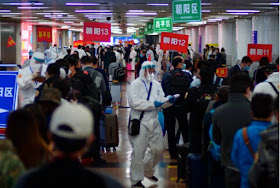[The reassessment counted 1,290 more deaths, bringing the death toll in the city where the outbreak was first recorded to 3,869. The revision came amid global efforts to produce more accurate data — and growing suspicions among experts and world leaders over how China’s death toll could remain relatively low even as death counts surge across the United States and Europe.]
By Siobhán O'Grady
 |
Passengers from Wuhan stand in lines designating where they will quarantine
in Beijing on April 15. (Sam McNeil/AP)
|
The reassessment counted 1,290 more deaths, bringing the death toll in the city where the outbreak was first recorded to 3,869. The revision came amid global efforts to produce more accurate data — and growing suspicions among experts and world leaders over how China’s death toll could remain relatively low even as death counts surge across the United States and Europe.
Zhao Lijian, a spokesman for the Chinese Foreign Ministry, insisted Friday that this revision in no way indicated a coverup and is based purely on standard efforts to take into account deaths that were previously miscounted or excluded.
But President Trump tweeted Friday that China’s numbers were even higher than officials there have disclosed, saying the deaths are “far higher than the U.S., not even close!”
Nationwide, China has reported a total of about 83,760 cases of the coronavirus and 4,632 deaths. Italy has reported a much higher rate of death among those diagnosed with the virus, with more than 172,400 cases and around 22,745 deaths. The United States has reported around 672,000 cases and more than 33,800 deaths.
Jude Blanchette, who leads China studies at the Center for Strategic and International Studies, said he doesn’t see it as coincidental that China publicly revised its numbers at a time of extraordinary international skepticism over how the relatively low death count compared to other hot spots around the world.
But he also said it is entirely possible that, like officials elsewhere, China is gaining new information about how many deaths previously classified as natural causes were in fact linked to the virus. Even in the United States, major discrepancies have emerged over how different states are counting and classifying deaths of people diagnosed with the virus, and experts say the U.S. death toll and case count are probably widely underestimated.
Several other countries have also revised their death tolls as they roll out new methods for counting the dead, expanding from just tallying hospital deaths to also including home deaths and deaths in nursing homes. Testing shortages and deaths of patients who contracted the virus but also had underlying conditions have only added to confusion over accurate counts.
“It’s naive to think there’s not a degree of politicization going on,” Blanchette said about China’s revised numbers. “But on the other hand, statistics aren’t meaningless in China and there are increasing limitations to how much China can mess with the numbers.”
Trump has accused the World Health Organization of having “pushed China’s misinformation about the virus,” and he suspended U.S. financial support to the U.N. agency this week. U.S. allies widely criticized that decision, although other leaders have expressed skepticism that China has been forthcoming about its outbreak.
In an interview with the Financial Times that published Thursday, French President Emmanuel Macron said “let’s not be so naive as to say [China has] been much better at handling this."
“We don’t know,” he said. “There are clearly things that have happened that we don’t know about.”
Facing mounting calls for more information about how many people died of the virus in Hubei province, China found itself in a conundrum in which it faced skepticism for its initial death count and would probably face skepticism for any revisions as well, Blanchette said.
“China is in a position where it’s damned if it doesn’t, damned if it does,” Blanchette said.
Wuhan, which is in Hubei province, reopened earlier this month, allowing residents to leave the city for the first time in 76 days, as long as they passed health checks confirming that they were not sick nor had they been exposed to the virus.
Officials in China are raising alarm over a growing number of cases reported in people who recently entered the country from abroad. Officials have introduced dramatic new restrictions on foreigners entering the country, citing concerns over imported infections from other hot spots. China also recently began classifying asymptomatic individuals who test positive for the virus separately from other cases.
The focus on imported infections, Blanchette said, signals that even if the country later revises its death toll or case numbers again, China’s Communist Party has created a blueprint that will allow Beijing to maintain the narrative that new infections can be blamed on returnees and foreigners and were “beyond its control.”
Rick Noack in Berlin contributed to this report.
Read more: